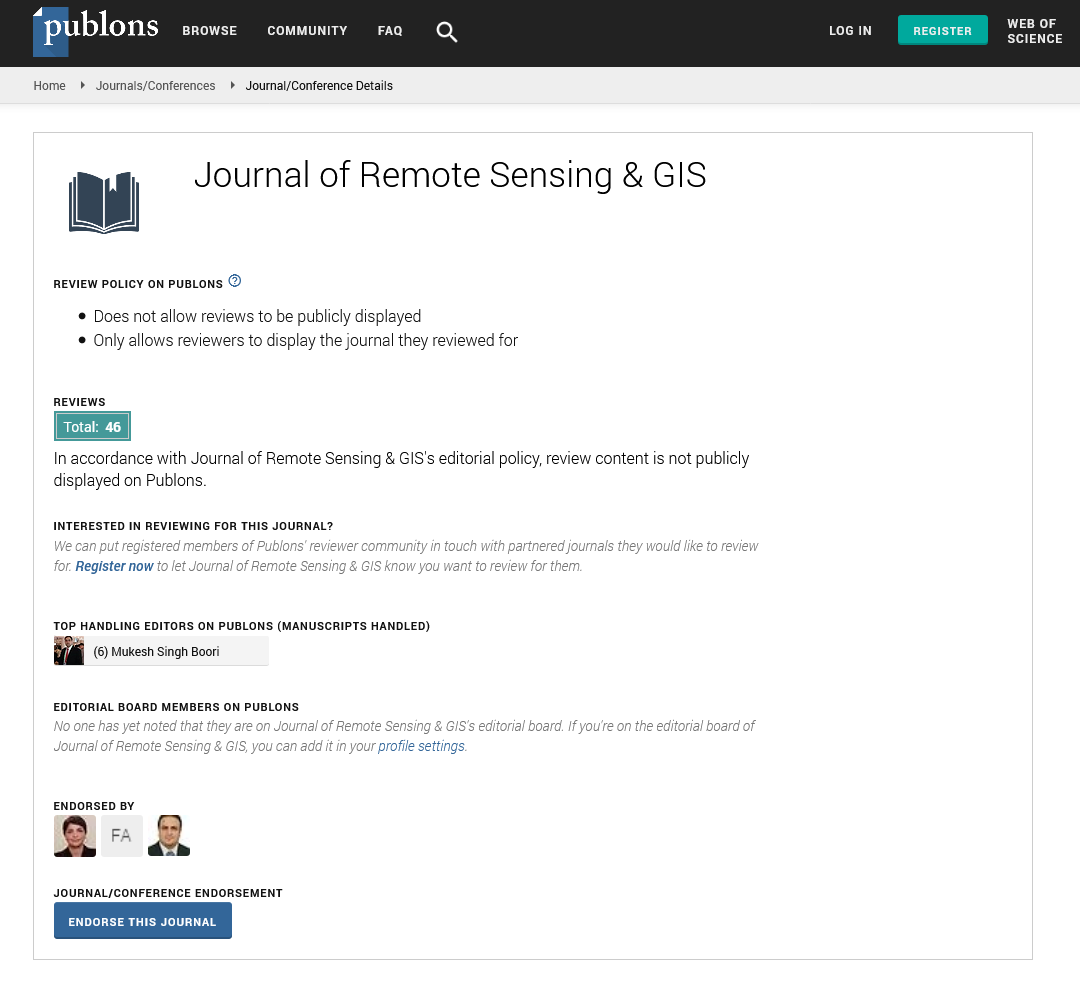Indexed In
- Open J Gate
- RefSeek
- Hamdard University
- EBSCO A-Z
- OCLC- WorldCat
- Publons
- International Scientific Indexing
- Euro Pub
- Google Scholar
Useful Links
Share This Page
Journal Flyer

Open Access Journals
- Agri and Aquaculture
- Biochemistry
- Bioinformatics & Systems Biology
- Business & Management
- Chemistry
- Clinical Sciences
- Engineering
- Food & Nutrition
- General Science
- Genetics & Molecular Biology
- Immunology & Microbiology
- Medical Sciences
- Neuroscience & Psychology
- Nursing & Health Care
- Pharmaceutical Sciences
Commentary - (2023) Volume 12, Issue 1
Spatial Analysis in Practice with Sophiticated Technology
Carly Peltier*Received: 02-Jan-2023, Manuscript No. JGRS-23-20206; Editor assigned: 05-Jan-2023, Pre QC No. JGRS-23-20206 (PQ); Reviewed: 19-Jan-2023, QC No. JGRS-23-20206; Revised: 26-Jan-2023, Manuscript No. JGRS-23-20206 (R); Published: 03-Feb-2023, DOI: 10.35248/2469-4134.23.12.278
Description
The communication technologies that have emerged in the past decade have allowed a fundamental change in the architecture of computing systems. Instead of the early mainframes and later stand-alone desktop systems, today’s computers are linked with high-speed networks that allow data, software and storage capacity located in widely scattered systems to be integrated into functioning wholes. Data can now be ‘served’ from central sites on demand, avoiding the need to disseminate many copies, with subsequent confusion when updates are needed.
Coleman reviews the architectural alternatives now common in computing systems and their technical impacts on GIS. The new approaches to computing that are possible in this interconnected environment are having a profound effect on spatial analysis. Because it is no longer possible to assume a lifetime association between a user and a particular system design, there are mounting pressures for standards and interoperability between systems to counter the high costs of retraining of staff and reformatting of data.
The proprietary GIS that once dominated the industry attempted to provide a full range of GIS services in one homogeneous environment. Data were stored in proprietary formats, often kept secret by vendors to maintain market position, but making it difficult for others to expand the capabilities of the system by programming extra modules.
The electronic data processing world to promote interoperability, open standards and formats and easy exchange from one system to another. While such ideas were often regarded as counter to the commercial interests of vendors, there is now widespread acceptance in the industry that they represent the way of the future. The implications of open systems for spatial analysis are likely to be profound. First, they offer the potential of a uniform working environment, in which knowledge of one system is readily transferable to another. To make this work, however, it will be necessary to achieve a uniform view, and its acceptance across a heterogeneous user community. There is no prospect of interoperability and open systems without agreement on the fundamental data models, terminology and objectives of GIS- based analysis. Thus much effort will be needed on the part of the inventors and implementors of spatial analysis to develop this uniform view. Second, the possibility of easy sharing of data across systems gives even greater momentum to efforts to make geographical information more shareable and even greater demands on the existence.
Third, interoperability is likely to create an environment in which it is much easier to implement methods of spatial analysis in Geographical Information System (GIS). Traditionally, vendors of monolithic systems have added functions when market demand appears to justify the development costs. It has been impossible, in a world of proprietary systems, for third parties to add significant functionality. Thus expansion of spatial analytic capabilities has been slow and has tended to reflect the needs of the commercial market, rather than those of science and problem-solving, when these diverge. In a world of open systems it will be much easier to add functions and the new environment will encourage the emergence of small companies offering specialized functionality in niche markets.
Conclusion
It is already possible in some mainstream software environments to launch one specialized application within another for example, to apply spreadsheet functions to information in a word processing package. This ‘plug and play’ environment offers enormous scope to GIS, since it will lead ultimately to a greater integration of GIS functions map and imagery data in general, into mainstream electronic data processing applications. The scientific world has grown used to a more or less complete separation between data and the functions that operate on and manipulate data. Functions are part of ‘analysis’, which plays a role in the traditional approach to problem-solving outlined earlier that is clearly distinct from that of data. But it has already been argued that in a world of extensive data sharing and interaction between disciplines it is impossible to think of data in isolation.
Citation: Peltier C (2023) Spatial Analysis in Practice with Sophisticated Technology. J Remote Sens GIS. 12:278.
Copyright: © 2023 Peltier C. This is an open-access article distributed under the terms of the Creative Commons Attribution License, which permits unrestricted use, distribution, and reproduction in any medium, provided the original author and source are credited.

